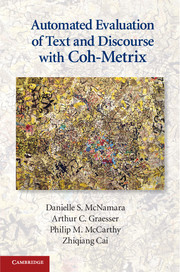Book contents
- Frontmatter
- Dedication
- Contents
- List of Figures
- List of Tables
- Acknowledgments
- Introduction
- Part I Coh-Metrix
- 1 What Is Text and Why Analyze It?
- 2 The Importance of Text Cohesion
- 3 The Science and Technology That Led to Coh-Metrix
- 4 Coh-Metrix Measures
- 5 Coh-Metrix Measures of Text Readability and Easability
- 6 Using Coh-Metrix Measures
- Part II A Beginner’s Guide to Writing Coh-Metrix Research
- Concluding Remarks
- References
- Appendix A Coh-Metrix 3.0 Indices
- Appendix B Coh-Metrix Indices Norms
- Index
6 - Using Coh-Metrix Measures
Studies of Cohesion in Text and Writing
Published online by Cambridge University Press: 05 June 2014
- Frontmatter
- Dedication
- Contents
- List of Figures
- List of Tables
- Acknowledgments
- Introduction
- Part I Coh-Metrix
- 1 What Is Text and Why Analyze It?
- 2 The Importance of Text Cohesion
- 3 The Science and Technology That Led to Coh-Metrix
- 4 Coh-Metrix Measures
- 5 Coh-Metrix Measures of Text Readability and Easability
- 6 Using Coh-Metrix Measures
- Part II A Beginner’s Guide to Writing Coh-Metrix Research
- Concluding Remarks
- References
- Appendix A Coh-Metrix 3.0 Indices
- Appendix B Coh-Metrix Indices Norms
- Index
Summary
We discussed in Chapter 2 the importance of cohesion and coherence to comprehension and how these findings were the main impetus for developing Coh-Metrix. Our primary goal in the Coh-Metrix project has been to develop, explore, and validate measures of text cohesion. Throughout the Coh-Metrix Project we have developed and implemented many approaches to assessing cohesion as well as other levels of language and discourse. The magnifying glass has primarily been on cohesion, so we have developed literally hundreds of cohesion indices that vary in generality (see Chapter 4 for the distinction between measure, index, bank, and variable). Some indices have targeted one general construct, such as referential cohesion, whereas others have drilled to a more specific level, such as temporal and verb cohesion. A significant portion of our efforts has gone toward rooting among the indices to choose the best ones and validating new ones. When there are many indices to measure a similar construct, it has been necessary to identify which ones rise to the top across the various studies and within studies. The indices need to be validated so that we have some assurance that they assess what we think they are assessing and that they are theoretically compatible with patterns of data corresponding to types of texts or human performance. For example, some studies show how particular indices account for differences between texts that fit predictions based on theory or well-accepted empirical findings. Alternatively, some indices are validated by patterns of data in psychological experiments using behavioral tasks. We have conducted many such validation studies. This chapter describes some of the studies we have conducted, particularly as they relate to referential, semantic, and situation model cohesion. The chapter begins by examining measures of cohesion in the context of empirical text comprehension studies and differences between types of text. We subsequently describe our work examining the role of cohesion in writing.
- Type
- Chapter
- Information
- Automated Evaluation of Text and Discourse with Coh-Metrix , pp. 96 - 112Publisher: Cambridge University PressPrint publication year: 2014



